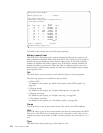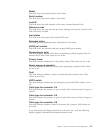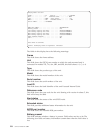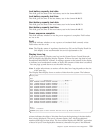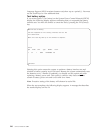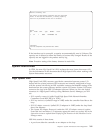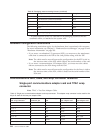
v An HSL connection which is either an internal connection or an external HSL
cable.
v A port from either an adapter on the loop or the controller.
Loops start and end on the same port pair of an HSL controller, for example, the
A0 and A1 ports.
When you view an HSL controller or adapter resource in HSM, you can select
Display detail option to view the status and information about the links on that
resource.
There are two ports on each HSL resource. The Leading link usually refers to the
connection between the resource’s 0 port to the next HSL resource on the loop. The
Trailing link usually refers to the connection between the resource’s 1 port to the
next HSL resource on the loop.
In some cases a link is an internal connection in a system unit or expansion tower.
In that case the link will be labeled as ″internal″ and there will not be port label
information.
When port pairs are on a system unit they are labeled on the frame as A0 and A1;
B0 and B1; and so on. When port pairs are on an expansion tower they are labeled
on the frame as 00 and 01.
Multi-adapter bridge
A multi-adapter bridge is a resource which provides the connection between PCI
I/O processors and a system PCI bus under an HSL I/O adapter (SI I/O adapter
in V4R5). The bridge controls a set of card positions that are labeled “PCI Bridge
Set” on the frames of system units and expansion towers. There can be more than
one multi-adapter bridge resource connected to a system bus. Each bridge resource
operates independently from any other bridge on the system bus and the bridge
controls only the card positions in its own PCI bridge set.
Resource names
Communications lines, I/O processors, and devices are system resources. All
system resources are identified by a resource name. To list the system resources, or
display and change resource names:
v See Chapter 2, “Hardware Service Manager” on page 45.
v Enter the resources command:
– WRKHDWRSC
During an IPL all powered-on resources that do not have a name are assigned a
name. The Licensed Internal Code assigns the name according to the order in
which the resource reports to the system. The resource name is used for
identification (by the Licensed Internal Code) during the next IPL, on displays, in
printouts, and during system configuration.
Note: Many system resources are identified by both logical and packaging
resource names. The logical and packaging hardware resources have
different resource names.
Use the following tables to identify the logical and packaging system resources.
For more information on system resources, see Chapter 2, “Hardware Service
242 Service Functions V5R2



